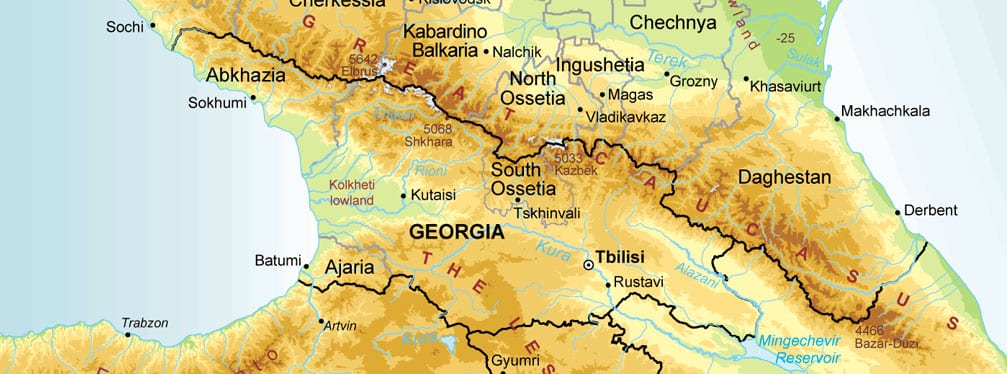

Georgia is situated at the crossroads of Europe and Asia. The country regained its independence in 1991, declaring its aspiration to join the European and Euro-Atlantic world and to regain its place in the European family to which Georgia has always belonged.
Georgia is situated in the Eastern European region of South Caucasus. In the southeast, it has a border with Azerbaijan, in the south with Armenia and Turkey, and in the north with Russia. The western part of Georgia meets the Black Sea, which connects Georgia physically to the European Union. The ancient capital of Georgia, Tbilisi, was founded in the fifth century.
Georgia comprises a total area of 69,700 square kilometres, with a population of 3,720,000. Pristine nature covers the vast part of the country, with 26,060 rivers and over 40 protected areas. With diverse climate zones, Georgia is a year-round destination. Here, subtropical and mild climate zones coexist. In summer the temperature fluctuates from 29 ° C to 33 ° C, with an abundance of sun. Winter temperatures average -2 ° C to 4 ° C.
Many famous writers and poets have taken inspiration from Georgia’s stunning nature and astonishing diversity. The country is increasingly popular among foreign travelers. In 2016, more than six million tourists visited Georgia. This is not surprising, as Georgia has just about everything a traveler might dream of: snowcapped mountains guarding clear lakes, alpine meadows, canyons painted by flowers and fruit and defined by rushing rivers, palm coasts, ancient caves, mineral waters and sulfur water pools. A visitor’s paradise, for sure!


Georgia’s capital Tbilisi is an ancient center of Caucasus. Its history counts 16 centuries. From the IV century Tbilisi is a hub of Georgian identity and allures all Georgian within.
The Capital is spread on 720 square kilometers. Lying on the banks of the Mtkvari (Kura) River 380-600 meters above sea level, Tbilisi bounded by south foot-fills of the Saguramo Range to the north, Iori plain’s northwest segment to the east and various endings of the Trialeti Range to the west and south.
Tbilisi has mildly warm humid subtropical climate. Typically winter is mildly cold and summer is hot. Average annual temperature is 12,7 °C; temperature in January is 0,9 °C and in July 24,4 °C.
Our country’s cultural life is concentrated in Tbilisi as well. It is a multicultural city hosting rich historic-cultural heritage and vibrant modern urban sub-culture with booming nightlife and creative arts.
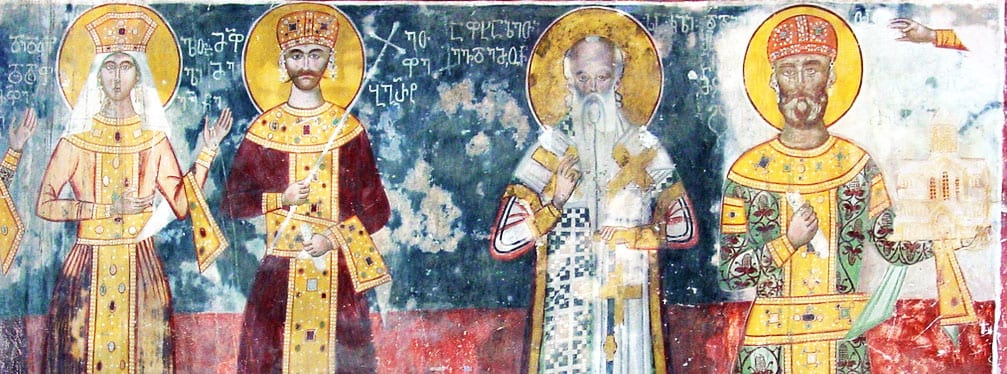

Geography has played an important role in Georgia’s historical development. Georgia is divided into two parts, each with its own distinct culture— Kolkhian in the west and Iberian in the east. In the 4th century B.C., King Parnavaz I established the first eastern Georgian state: the Kingdom of Kartli. The Parnavazian Dynasty in Kartli lasted until 65 B.C. Georgian historical chronicles date the creation of the Georgian alphabet to King Pharnavaz I’s reign.
In the 4th century A.D., schools of rhetoric and philosophy based in the city of Pazisi (modern Poti) translated ancient books and manuscripts. Original hagiographic literature was also written in Georgian. The earliest have survived until today. The Martyrdom of St. Shushanik was written in the 5th century, followed by The Martyrdom of Evstate Mtskheteli in the 6th century. The Kingdom of Kartli was invaded by the Persians in the 5th century during the reign of King Vakhtang Gorgasali, one of many Persian invasions over many centuries. Gorgasali is notable for moving the capital of the country from Mtskheta to Tbilisi and implementing church reforms.
In the 11th–12th centuries, Georgia flourished. In 1089, King George II yielded the throne to his 16-year-old son Davit. Davit IV went on to become one of the nation’s most prominent monarchs, and today he is considered as one of the most significant political figures in the nation’s history. Georgians refer to him as “Davit the Builder” (Agmashenebeli) because he unified the country and initiated many valuable reforms. Among the most notable was the unification of the Georgian church in 1103, which Davit IV set in motion by summoning the heads of the churches from all over the country to an ecclesiastical gathering known as the Ruisi-Urbnisi Church Council. He also established a regular army, which enabled him to defeat and expel Turks from the Georgian lands they occupied and to strengthen the state.
This period of prosperity in Georgia reached its peak during the reign of Queen Tamar (1184–1213). At that time, Georgia became the most powerful country in Asia Minor. It was able to defend itself from the Turkish invaders, and also to expel invaders from other South Caucasian kingdoms. The victorious battles of Shamkori (1195) and Basiani (1202) are considered highlights of Georgian military history. The 11–12th centuries also witnessed the Golden Age of Georgia. Shota Rustaveli wrote his masterpiece of the Georgian national culture, the epic poem “The Knight in Panther’s Skin,” in this period.
From the early 14th century, Georgia suffered from numerous invasions by Mongol hordes. Tamerlane the Great himself raided Georgia eight times between 1386–1403, devastating the country’s economy and reducing its thriving cities to ruins. The economic recession caused by continuous invasions combined with treachery among ruling feudal clans to divide Georgia into three separate kingdoms: Kakheti, Kartli, and Imereti.
In the 18th century, King Vakhtang VI introduced important reforms in an attempt to save the country from economic and political collapse. His reign is also noteworthy for the establishment of the first Georgian printing house, which produced Georgia’s first printed book, Rustaveli’s “The Knight in Panther’s Skin,” in 1712.
From the 1720s, Turkish invaders again occupied Georgia. King Erekle II (nicknamed “Patara Kakhi”) who ruled from 1744–1798 took energetic steps to unify the eastern parts of Georgia— the kingdoms of Kartli and Kakheti—while simultaneously fighting for independence from the Ottoman and Persian Empires. Erekle proved unable to defend Georgia from invaders solely with his forces, so he appealed to Orthodox Russia for support. The Bilateral Treaty of Georgievsk was concluded between the Russian Empire and the east Georgian kingdom of Kartli-Kakheti in 1783. This treaty established eastern Georgia as a protectorate of Russia, which guaranteed its territorial integrity and the continued reign of Georgia’s royal Bagrationi dynasty in return for Russia’s being allowed to intervene in the conduct of Georgian foreign affairs.
In 1891, Georgia was annexed completely by the Russian Empire. The Russians ignored Georgian habits and traditions and sought to eradicate Georgian culture and the Georgian language. Most frescos in Georgian cathedrals were white-washed; Russia abolished both the status of the Patriarch of Georgia and the autocephaly of the Georgian Church.
Georgia gained short-lived independence from czarist Russia in 1917 as Russia descended into revolutionary chaos when the Democratic Republic of Georgia, with a provisional government, was established. In March of the same year, the Georgian church regained its autocephaly, and a new patriarch, Kirion, was elected. In 1920, Russia recognized the independence of Georgia. Great Britain, France, Italy, and Japan followed suit. But in February of 1921, Tbilisi was occupied by the Red Army of Soviet Russia, and the democratic government of Georgia was forced to flee. For the next 70 years (1921–1991), the Soviet Socialist Republic of Georgia was one of the 15 constituent republics of the Soviet Union until the breakup of the USSR.
MORE – gov.ge
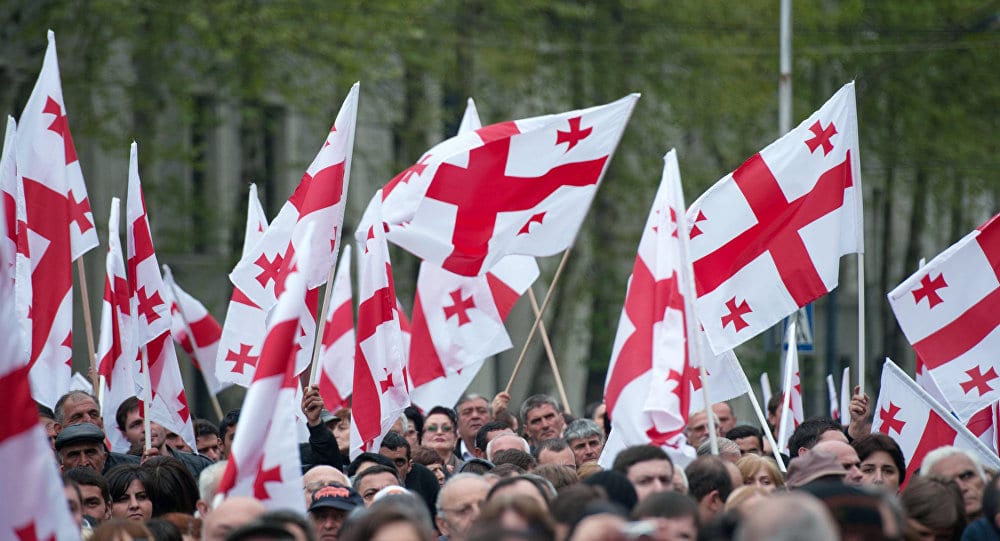

Georgia Reclaims its Independence and Consolidates Democracy
Georgia was one of the first Soviet republics to move aggressively for independence. This process was accelerated by the events of 9 April 1989, when Soviet soldiers brutally crushed a peaceful rally in Tbilisi, killing 21 protestors. This lethal crackdown resonated deeply in many republics of the Soviet Union, particularly in the Baltic countries, thereby further stimulating the collapse of the Soviet Union.
Through elections held on 28 October 1990, Soviet Georgia died, and a free Georgia was reborn. The Round Table-Free Georgia party, headed by former political dissident Zviad Gamsakhurdia, won a convincing victory. On 31 March 1991, Georgian citizens overwhelmingly approved a referendum on the restoration of the country’s independence, and, on 9 April 1991, the Supreme Council adopted Georgia’s Declaration of Independence. On 26 May 1991, presidential elections saw the victory of Gamsakhurdia, the first president of independent Georgia.
In 1991, protests against President Gamsakhurdia descended into civil war. Gamsakhurdia and his supporters were ousted from Georgia in January 1992. For the following two months, the country was governed by a so-called Military Council, whose members were former Prime Minister Tengiz Sigua, former Minister of Defense Tengiz Kitovani, and the head of the Mkhedrioni militia Jaba Ioseliani. In March 1992, Georgian native Eduard Shevardnadze, former foreign affairs minister of the USSR, arrived in Georgia from Moscow to lead the Military Council.
Additional conflicts arose in Georgia’s Autonomous Republic of Abkhazia and the Autonomous Region of Southern Ossetia. Separatist forces, with assistance from Russian military divisions and mercenaries of the Confederation of the Peoples of Northern Caucasus, defeated Georgian forces. These regions broke away from Georgia in September 1993.
In 1995, the Constitution of Georgia was adopted, followed by presidential and parliamentary elections. As a result of the presidential elections, Eduard Shevardnadze, until then Georgia’s de facto leader, was officially elected president, a post he would hold until 23 November 2003. In 1999, parliamentary elections were held again, and the ruling Citizens’ Union party was declared the winner.
On 2 November 2003, the next parliamentary elections took place, and despite widespread election irregularities, the Central Election Commission awarded victory to the pro-government bloc For New Georgia. Protestors took to the streets of Tbilisi demanding new parliamentary elections. These reached a climax on 22 November at what is often called the “Rose Revolution,” which ignited during the first session of the newly elected parliament. The protest was led by opposition leaders Zurab Zhvania, Mikheil Saakashvili, and Nino Burjanadze. On 23 November, in the presence of Saakashvili, Zhvania, and the Minister of Foreign Affairs of Russia Igor Ivanov, President Shevardnadze officially resigned. In accordance with Georgia’s Constitution, Burjanadze, as speaker of the parliament, took over the duties of president.
On 4 January 2004,Mikheil Saakashvili won the ensuing presidential elections with 97 percent of the vote. On 17 February 2004, after amending the Constitution of Georgia, Zhvania became prime minister. The parliamentary elections of 28 March 2004, were won by the ruling National Movement/Democrats bloc, with Burjanadze being re-elected speaker of the parliament.
Increasing concerns over human and property rights violations in the country led to a series of demonstrations against the ruling party. Significant clashes between the government and protesters, in which the government used excessive force, occurred in November 2007 and May 2009.
On 7 August 2008, Russian military forces invaded Georgia, resulting in a brief war. As the war ended, Russian President Dmitry Medvedev signed an order recognizing the independence of two breakaway regions of Georgia – South Ossetia and Abkhazia. Besides the Russian Federation, only Venezuela, Nicaragua, and Nauru recognized these regions’ independence from Georgia. The rest of the international community remain committed to territorial integrity and recognize South Ossetia and Abkhazia as integral parts of Georgia.
However, since the war, the Russian Federation has increased its permanent military presence in and beyond the two occupied regions, including areas which were under Georgian government control before the war, in direct violation of the EU-brokered ceasefire agreement of 12 August 2008. Today, South Ossetia and Abkhazia remain occupied territories held by over 10,000 active duty military personnel of the Russian Federation on the ground.
Parliamentary elections of 2012 witnessed the first peaceful transition of power in Georgia’s post-Soviet history, from Mikheil Saakashvili’s party, United National Movement, to the Coalition Georgian Dream, led by billionaire Bidzina Ivanishvili, who became prime minister of the victorious party. Saakashvili, who had earlier been elected president, remained in power.
In November 2013, President Saakashvili was replaced by Georgian Dream coalition candidate Giorgi Margvelashvili. The presidency was made a less influential position through constitutional changes enacted at the time of his inauguration, with key powers transferred from the president to the prime minister.
In 2013, Prime Minister Bidzina Ivanishvili stepped down to honor his election promise to stay in that position for only one year. The ruling coalition named Interior Minister Irakli Garibashvili as new prime minister. The current leader of the Georgian government, Giorgi Kvirikashvili, who previously served as Foreign Minister and Minister of the Economy, took over as a prime minister following the resignation of Irakli Garibashvili in December 2015. In June 2018, Mamuka Bakhtadze became the Prime Minister of Georgia after the Parliament of Georgia confirmed his nomination. Bakhtadze previously led the Ministry of Finance of Georgia.
In November 2018, after the second round of the presidential elections, Georgian people elected new President Salome Zourabichvili – the first female to hold the presidential post in the history of Georgia.
Since 2012, Georgia has held five nationwide elections (parliamentary, presidential, and municipal). Recognized international organizations and observers rated all as free and fair, emphasizing the authentic democratic development of Georgia.
More- gov.ge
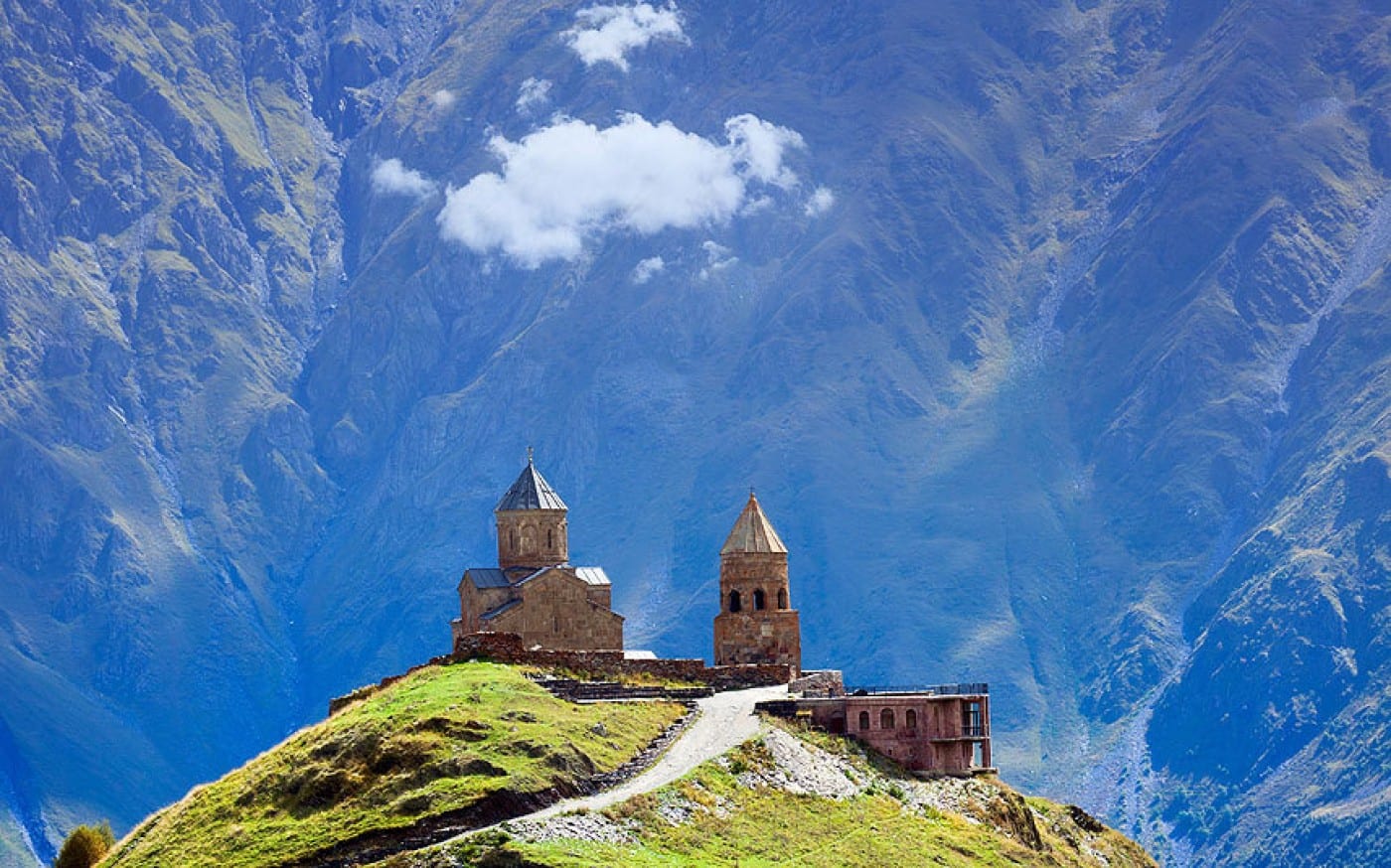

Christianity first reached Georgia in the 1st century A.D. The Apostles Andrew the First, Simon the Zealot, and Matthias were the first to preach the teachings of Christ here. In approximately 330 A.D., St. Nino of Cappadocia came to Georgia to spread Christianity. History credits St. Nino with having healed the mortally ill Queen Nana and later converting King Mirian to Christianity. Legend has it that one day, while King Mirian was hunting, the sky blackened. The King turned to the God of Nino to ask for help, and miraculously, the sun shone again! Soon after this legend, Christianity was established as the official religion in Georgia. A thriving Christian scholarly and cultural life followed. The activities of renowned scholars and philosophers Petre Iberieli and Ioane Lazi are especially noteworthy. The magnificence of the Svetitskhoveli cathedral church, erected in Mtskheta in 11th century, exceeds the limits of human thought and imagination.
The Georgian Orthodox cross with its sloping crosspiece is named after St. Nino, who made it from grape branches and her own hair. St. Nino preached the Gospel in Georgia holding the grapevine cross in her hands. Before St. Nino’s arrival in Georgia, Georgians used to worship Mazdean idols and fire.
The first Episcopal Chair was established in Mtskheta, the capital of the Kingdom of Kartli. The head of the Kartli regional church held the title of Archbishop. Until the 5th century, the Georgian Orthodox Church was hierarchically subordinate first to Constantinople and then to the Antioch patriarchates. During the reign of King Vakhtang Gorgasali (466 to 468 AD), 12 Episcopal Chairs were established in the Kartli Region, and the head of the church was given the title of Catholicos. It was then that the Georgian Church became autocephalous.
In the 6th century, the Assyrian Brothers contributed to strengthening the Christian faith in Georgia. The Patriarchate established in Georgia in the 11th century was the sixth in the world. Under the reign of Davit IV the Builder, however, the Georgian church was brought under state control and Giorgi Chkondideli Mtsignobartukhutsesi was appointed as its supervisor.
The Orthodox Church played a significant role in developing literacy in Georgia; schools and academies functioned continually within monasteries and churches (in Iqalto and Gelati) where priests and monks relentlessly pursued their scholarly activities, creating important hagiographic works.
Following the Russian Empire’s annexation of Georgia, the autocephaly of the Georgian Orthodox Church and the office of Catholicos-Patriarch were abolished. The Georgian Church was incorporated into the Russian Synod as its exarchate. In the years from 1852 to 1869, church property was transferred to the state treasury, and the clergy started to receive regular salaries. On 12 March 1917, the Georgian church restored its autocephaly, and in September of the same year a new Catholicos-Patriarch was elected.
In 1978, Ilia II was enthroned as Catholicos-Patriarch of all Georgia. Since his accession to the office of patriarch, numerous churches and cathedrals have been built and restored in Georgia. Worth special mention is the Holy Trinity (Sameba) Cathedral, which is one of the largest monastic compounds in the world, which will comprise 12 churches and chapels on its territory.
More- gov.ge
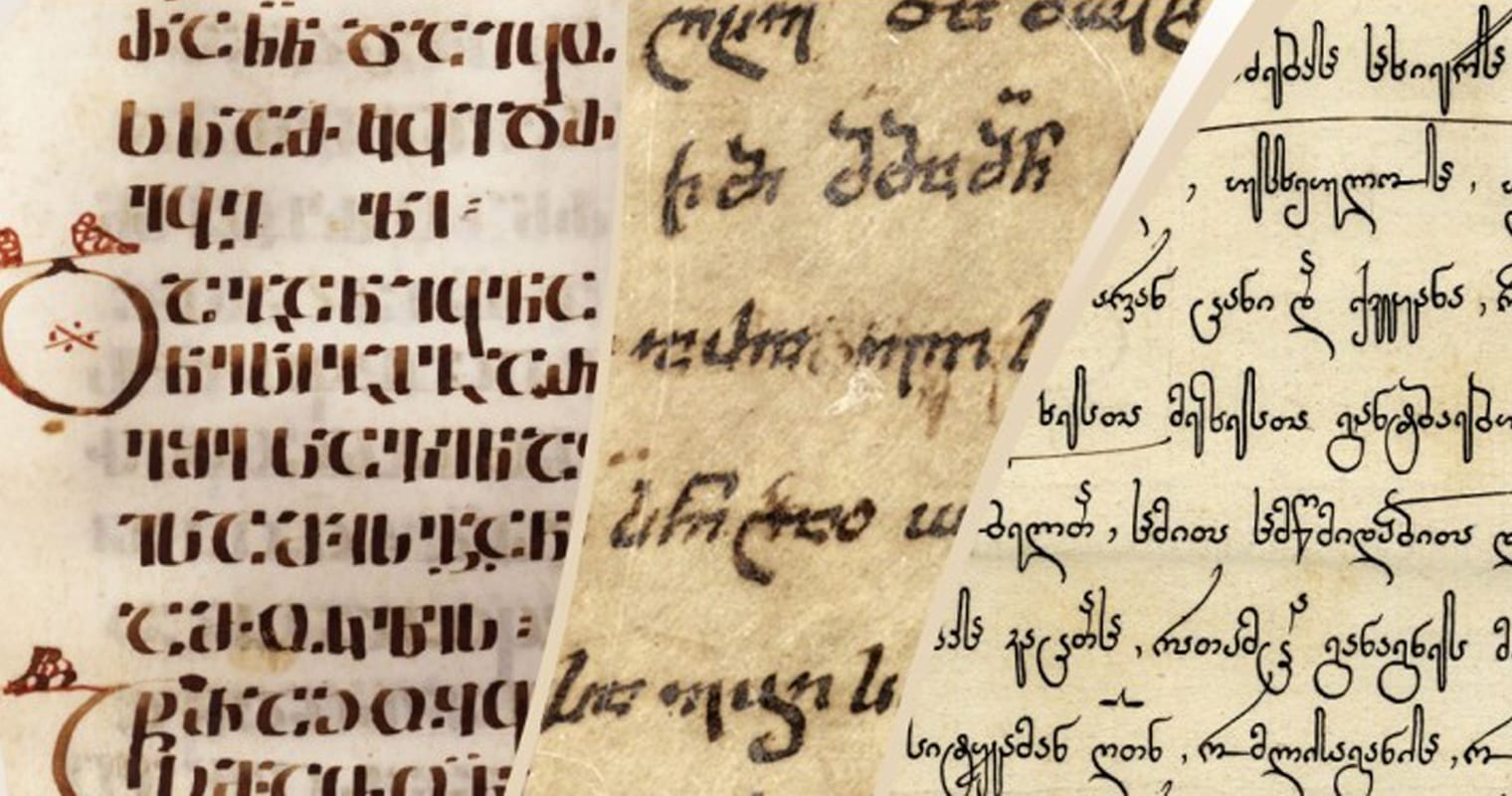

Georgian is the official language of Georgia. In the Autonomous Republic of Abkhazia, Abkhazian is co-official language, along with Georgian. Georgian is spoken by approximately seven million people worldwide. It belongs to the family of Ibero-Caucasian languages, falling within the Kartvelian branch. Other family members of the Kartvelian language are Megrelian, Laz, and Svan. They have retained many archaic features of the Georgian language.
A thorough study of Kartvelian languages and dialects reveals historical peculiarities of the development of the Georgian language. The modern Georgian language distinguishes seven cases of nouns and has a very complicated system of verb conjugations. Each region of Georgia has a variety of dialects including, Kartlian, Kakhetian, Pshavian, Tushetian, Khevsurian, Mtiulian, Mokhevian, Ingiloian, Imeretian, Gurian, Ajarian, Lechkhumian, Rachvelian, Meskhetian, Javakhian, Imerkhian and Fereidanian. The history of the Georgian language is divided into two periods— the ancient one (from the archaic era to the late 11th century) which is marked by a series of phonetic, morphological, and lexical differences and variations; and ancient Georgian literary language represents a strictly regular system of linguistic norms.
Modern Georgian literary language was formed in the 12th century, based largely on Kartlian and Kakhetian dialects. Georgian writers Ilia Chavchavadze, Akaki Tsereteli, Jakob Gogebashvili, Silovan Khundadze, and other outstanding Georgian figures made a valuable contribution to the establishment of modern Georgian literary language.
Modern Georgian is written in an alphabet called Mkhedruli, which evolved from the Nuskhuri script, which in turn derives its origin from Asomtavruli (round-shaped letters). The Mkhedruli script consists of 33 letters and fully corresponds to the standard script for modern Georgian consisting of 28 consonants and 5 vowels. The Asomtavruli inscriptions found on Davit’s fresco (4th century A.D.) and on the walls of the Bolnisi Sioni Church (492–493 A.D.) are considered to be the oldest examples of Georgian writing. Archaeological excavations at the Nekresi Monastery (Kakheti), conducted in the 1990s and in 2002–2003 by the late Georgian archaeologist and academician Levan Chilashvili, have proved that the Georgian alphabet was created long before the spread of Christianity in Georgia. The excavations have brought to daylight the remains of a pagan temple. A ceramic vine vessel and a vine press found there feature inscriptions dating back to the 1st and the 2nd centuries A.D.
UNESCO has recognized the ‘Living culture of three writing systems of the Georgian alphabet’ as the world cultural heritage.
More- UNESCO Web Page
More- archives.gov.ge/
